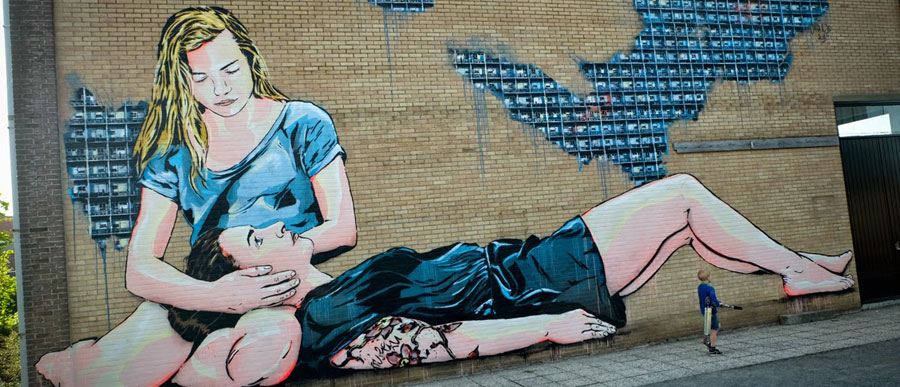
Street art is a term which loosely covers all forms of visual art displayed in a public location. More specifically, artists seek to situate their work into non-art contexts, so that it presents a digression from the norm, and perhaps reaches a wider demographic, free from the confines of a traditional gallery environment. It is a movement intrinsically connected with graffiti, and there are critics who label street art entirely as vandalism. Often street art is removed or damaged, whether deliberately or not, because of its exposure; the Parachuting Rat, a work by Banksy (one of the most infamous street artists) in Melbourne was painted over in 2010 by council contractors, and eventually destroyed by builders working on plumbing in 2012.
Belgium has a rich artistic history dating back to medieval times. From the most famous Belgian surrealist painter, Rene Magritte, Herge, who wrote The Adventures of Tintin. Comic art became popular in the 1920s and is considered an essential part of Belgium’s visual culture; there’s even a museum dedicated to it, the Belgian Comic Strip Centre. Today, there are examples of street art to be found all over the country; you just have to know which corner to peer round.
Belgian Street Artists
ROA
Belgian street artist ROA – pseudonym, or course – has work appearing on the sides of semi-derelict buildings, splashed across shop shutters, and peering through the cracks of virtually every major city in the world, from London to Chicago, across to Perth and back to Berlin. He began painting his distinctive animal portraits in isolated industrial estates in his hometown, Ghent. Examples of ROA’s work can still be seen on abandoned buildings and warehouses in the area.
The animals he portrays are often native to the local environment, and generally appear in a dead or decomposing state. In a colour palate comprised mainly of shades of black, white, and red, he creates graphic representations of hair, skin, flesh, internal organs, and bones. The animals interact with their environment, slumped lifelessly over the architectural features of the buildings they inhabit. Often the images make a commentary on the role of the space, such as the imposing skeleton of a whale emblazoned across the side of a building once used to gut fish in Norway, where whale hunting still takes place.
Strook
Artist and illustrator Stefaan Da Crook, otherwise known as Strook, creates elaborate multi-media murals, often on a large scale. His intricate designs are made up of provocative linework shapes and patterns. These merge to display larger images, such as faces, animals, and landscapes. As well as creating images on standard art materials, such as paper and canvas, Strook has encorporated wood, cloth, and steel, and has produced large-scale works on huge glass windows and on the side of buildings.
What is perhaps Strook’s most unusual and intriguing piece was created on a wall on the outside of the STUK Art Centre, in Leuven, Belgium. Using the moss which had naturally formed on the wall and a pressure washer, he carved out intricate shapes and designs from the organic matter to form a large mural of a bird. The nature of this piece of work is to be temporary, as the moss will continue to grow, evoking the nature of street art as a transitory feature of an ever changing urban environment.
Steve Locatelli
Brussels born Steve Locatelli’s street art began with a passion for graffiti in the 90s. Playing with the boundaries of legality, he began with graffiti on the Brussels Metro. Today, he owns a shop in Antwerp called ‘Artifix’, selling materials and graffiti art inspiration, as well as his own artistic creations. Examples of his work in situ are found in Antwerp, Brussels, and Ghent. His art has also featured in ad campaigns for companies such as Desperados and Nissan.
Stylistically, his street art incorporates elements of both a more ‘painterly’ style with the effect of spray paint, a nod to Locatelli’s roots in graffiti art. They often contain images of faces, sometimes contorted or screaming, as well as animals and skulls, which are beneath smudges of bright, bold colour. Generally his work is done on a large scale, sometimes taking over the whole side of a building.
Isaac Cordal
Belgian based Isaac Cordal’s work will make you totally reassess your perception of street art; it is nothing like the colossal portraits which take up half of a two story building that are often associated with this movement. Cordal’s work could not be any less in-your-face; in fact, his miniature cement figures are very much of the blink-and-you’ll-miss-it school of art. What they lack in stature they make up for in message, though. The sad little figurines depicted trudging sadly in a row, steadily deeper into a puddle, in a piece called ‘Follow the Leader’. A half-sunken and chilly looking man in a gas mask and swim shorts is the star of ‘Summer in London’.
Past Belgian exhibitions include ‘Waiting for Climate Change’, which was displayed on the beach of De Panne in eight different locations along the coast. Some figures, clad in rubber rings, stand atop wooden poles and stare out to sea. Others clutch briefcases as they are engulfed by the sand, with mobile phones in hand.
Great travel articles as well as deals, all sent directly to your inbox. Sign up today!
